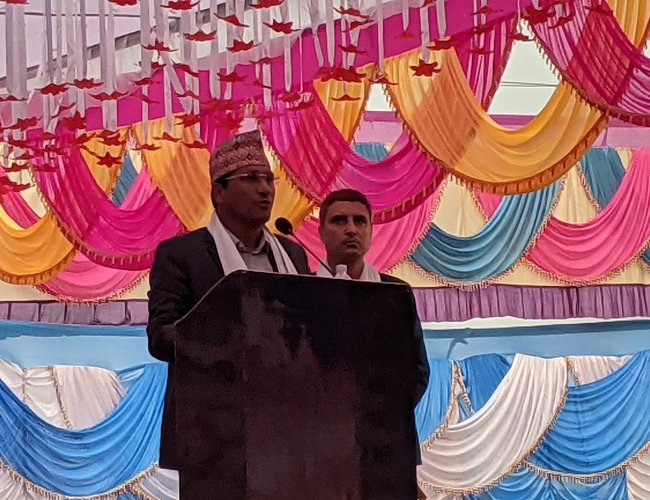
The Nepal Electricity Authority (NEA) has decided to encourage investment in electricity by domestic small investors by opening Power Purchase Agreements (PPAs) for hydropower projects up to 10 MW.
During its 963rd meeting on January 24, the Authority's Board of Directors, chaired by Minister of Energy, Water Resources, and Irrigation Shakti Bahadur Basnet, decided to enter into power purchase agreements (PPAs) for run-of-the-river (ROR) and semi-reservoir (PROR) hydropower projects with a capacity of up to 10 MW, under a 'take or pay' basis.
Electricity for the projects will be purchased at different rates depending on the season. During the dry season (Mangsir-15th to 15th Jestha), the rate will be Rs 8.40 per unit, while during the rainy season (16th May-15th December), it will be Rs 4.80 per unit.

Kulman Ghising, Managing Director of Nepal Electricity Authority, stated that the PPA limit, which is set at half of the Energy Mix in projects up to 10 megawatts, does not apply to maximize the use of local natural resources and encourage domestic small investors to invest in the hydropower sector.
Managing Director Ghising stated that due to the quota, PPAs for hydropower projects up to 10 MW were not possible. However, now that the quota is no longer applicable to projects up to 10 MW, PPAs can be made whenever and wherever the capacity is available. This change will encourage small domestic investors.
The authority has received applications for PPA from 89 projects up to 10 MW, with a total capacity of 351 MW. Among them, 44 projects with a capacity of 195 MW have already completed grid-related agreements.
To achieve the goal of producing 15,000 megawatts in the next ten years and become self-sufficient in electricity in the long term, the production mix was determined. The power system will consist of 25% reservoir projects, 30% peaking ROR, and 45% ROR.
The limit of PPA was set based on this mix. Due to the completion of the 6750 megawatt limit for ROR projects, PPAs cannot be granted to projects exceeding 10 megawatts. Due to the completion of the 6750 megawatt limit for ROR projects, PPAs cannot be granted to projects exceeding 10 megawatts. It is worth noting that most projects under 10 MW are ROR. The Authority has already completed PPAs for 9200 MW.
The Board of Directors has decided to purchase additional electricity if the capacity of the hydropower projects that have already signed PPAs is increased.
The Authority has decided that the PPA limit will not apply if the project's connected capacity increases by up to 25 percent. Kulman Ghising, the authority's executive director, stated that the PPA will be amended to allow for the 'taking or sending' of electricity produced by increasing the installed capacity up to 25 percent due to changes in the project's design.
If the capacity is increased by up to 25 percent, we will use the 'take or go' system. If the increase exceeds 25 percent, we will apply the old 'take and go' system. This new system will increase the project's capacity and facilitate investment.
The authority has raised the limit of power purchase agreements (PPAs) for solar and hydropower projects. Solar project PPAs are now awarded through competition.
The authority will conduct a competitive PPA for solar energy, limited to 10% of the total capacity of the national grid, including existing connected capacity and previously PPA'd projects.
Previously, solar project PPAs were limited to 10% of the connected capacity of the national grid.
The maximum base rate for purchasing solar power from competition is 5.94 INR per unit. The bidder with the lowest rate in the competition will be awarded the project.
We will conduct a competition for Power Purchase Agreements (PPA) for solar projects with a capacity of approximately 800 MW to be built near our 200, 132, and 33 KV substations under the new arrangement.
Priority has been given to solar energy projects connected to the grid to meet the growing demand for electricity in winter. Executive Director Ghisingh stated that hydropower projects require more time to build, while solar projects can be completed within a year and a half. Additionally, the land surrounding the substation will be utilized.
The NEA has completed a PPA for 175 MW through competition, with 106 MW already in operation and an additional 30 MW in the process of PPA.
- Nepal’s Largest All-Female Hackathon 2025 Concluded
- Jul 15, 2025
- Nepal Needs a Coordinated Security Mechanism and De-radicalisation Program to Counter Terrorism
- Jul 15, 2025
- FOODMANDU Committed to Make ‘Life Ajhai Better’
- Jul 15, 2025
- Om Vedic Foundation Inaugurates with Grand Ceremony
- Jul 15, 2025
- Weather Forecast: Generally Cloudy Across The Country heavy rain in one or two places in Koshi,Gandaki, Lumbini, and Karnali Province
- Jul 15, 2025














